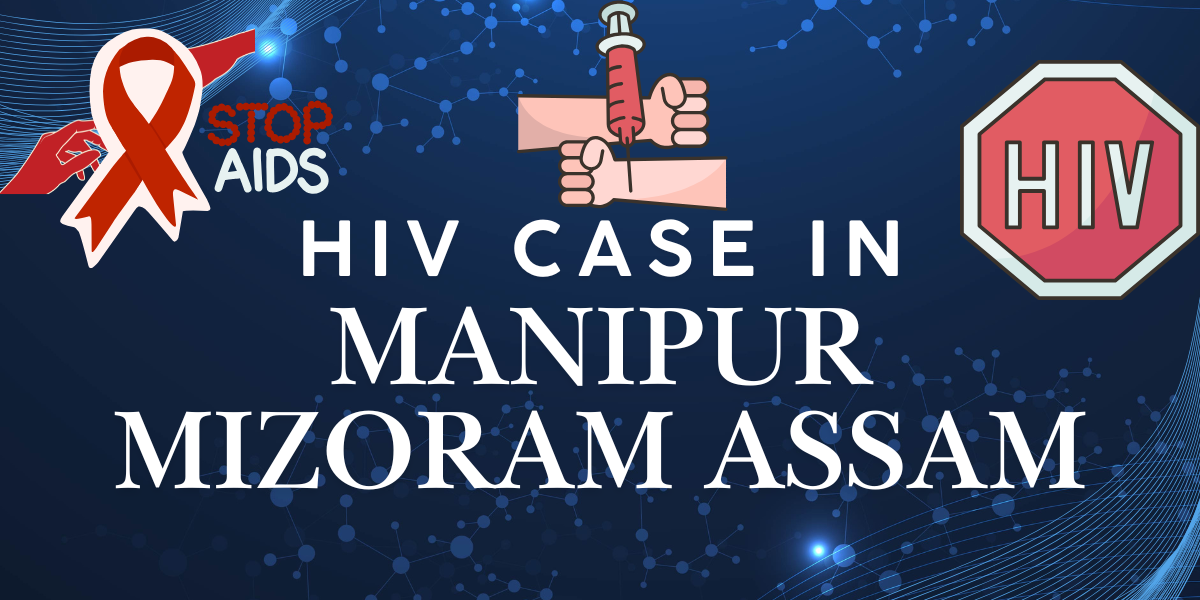The Rise of HIV in Northeast India: Focus on Manipur, Mizoram, and Assam
Understanding the Crisis, Symptoms, and Prevention Strategies
Introduction
The northeastern region of India, particularly states like Manipur, Mizoram, and Assam, has witnessed a concerning rise in HIV (Human Immunodeficiency Virus) cases over the past two decades. While HIV rates have declined nationally, these states remain hotspots, raising public health alarms.
But what’s driving this increase, and how can communities and individuals respond?
2016 The Hindu Report, 40,855 HIV positive cases in Manipur
Which district in Manipur has the most HIV infection? Imphal & Churachandpur on top
HIV in Northeast India: What the Numbers Say
- Mizoram has consistently recorded the highest HIV prevalence rate in India, with recent studies suggesting over 2% of the population is affected.
- Manipur, once labeled the epicenter of the HIV epidemic in India, still sees high transmission rates, especially among injecting drug users (IDUs) and young people.
- Assam, while historically lower in prevalence, is now showing a steady rise in cases, especially in border and urban areas.
These states share several risk factors:
🔹 Proximity to drug trafficking routes
🔹 High rates of injecting drug use
🔹 Social stigma and lack of awareness
🔹 Limited access to healthcare and testing facilities
Key Causes Behind the HIV Rise
1. Injecting Drug Use (IDU)
- Shared needles remain the leading cause of HIV transmission in Manipur and Mizoram.
- Border trade routes make heroin and synthetic drugs easily accessible.
2. Unprotected Sex
- Stigma and lack of sex education result in low condom use.
- Young people, especially in urban centers and colleges, face higher vulnerability.
3. Stigma and Discrimination
- Fear of being ostracized prevents people from getting tested or seeking treatment.
- Myths and misinformation exacerbate the problem.
Common Symptoms of HIV
HIV symptoms can vary based on the stage of the infection:
🛑 Early (Acute) Stage (2–4 weeks after infection):
- Fever
- Sore throat
- Rash
- Swollen lymph nodes
- Muscle aches and fatigue
Often mistaken for flu, this is the most contagious phase.
🔄 Chronic (Latent) Stage:
- May have no symptoms for years
- The virus is still active and slowly damages the immune system
❗ Advanced Stage (AIDS):
- Rapid weight loss
- Prolonged fever and diarrhea
- Severe infections (e.g., TB, pneumonia)
- Skin lesions
- Memory loss or neurological issues
Prevention: What Can Be Done?
✅ 1. Safe Practices
- Use condoms consistently during sex
- Avoid sharing needles or syringes
✅ 2. Regular Testing
- Early detection allows for timely treatment
- Encourage HIV screening among high-risk groups
✅ 3. Awareness & Education
- Launch school and college awareness programs
- Involve community leaders and influencers
✅ 4. Antiretroviral Therapy (ART)
- ART can control HIV, prevent AIDS, and reduce transmission
- Available free of cost in India through government programs
✅ 5. Needle Exchange Programs
- Offering clean needles to IDUs reduces the spread
- Combined with counseling and rehabilitation support
Role of Society and Government
Efforts from both government health agencies and civil society organizations are key. Northeastern states require targeted interventions—combining healthcare infrastructure, behavioral change programs, and community outreach. The Rise of HIV in Northeast India
HIV CASE IN MANIPUR
As of August 2024, Manipur reported a total of 24,472 people living with HIV/AIDS (PLHIV). However, only about 14,200 individuals were receiving Antiretroviral Therapy (ART) at that time. This indicates a significant gap in treatment coverage, with approximately 58% of those diagnosed not yet on ART .(thesangaiexpress.com)
Despite these challenges, Manipur has made notable progress in reducing the transmission of HIV from mother to child. Through the Prevention of Parent to Child Transmission (PPTCT) program, the state has achieved a nearly zero transmission rate, with only 0.13% of pregnant women testing positive for HIV in 2019–2020 .(ifp.co.in, ifp.co.in)
The state’s HIV prevalence rate among adults remains the highest in India at 0.87%, reflecting the ongoing need for enhanced awareness, testing, and treatment initiatives .(tsacs.tripura.gov.in)
For a more detailed overview of HIV statistics in Manipur, you can refer to the National AIDS Control Society’s (NACO) India HIV Estimates 2023 factsheet.(tsacs.tripura.gov.in)
💡 Let’s talk, test, and treat—because HIV is preventable, and with timely care, it’s manageable.

SEBI – RBI – NABARD Descriptive Q & A 2025
Student insider20 descriptive Q&A (150 words each) on the objectives and functions of SEBI, NABARD, and…

Current affair National & International 2025
Student insiderOrganizations & Current Affairs Quiz National & International Organizations and Current Affairs Quiz 1. What…

How to become an Investment Bankers in india
Student insiderTo become an Investment Banker in India, there is no single fixed course, but a…

Major Global Summits for competitive exam in india
Student insiderGlobal Summits MCQ Quiz Global Summits Quiz – 50 MCQs Submit Answers

World Bank & Swiss Bank General Awarness for Competitive exam
Student insiderWorld Bank International Organization:The World Bank is a global development cooperative owned by 189 member…

General Awareness for any competitive exam 2025
Student insider🔷 Section A: Blood Relations (Q1–Q5) Q1. Pointing to a girl, Rohan said, “She is…




